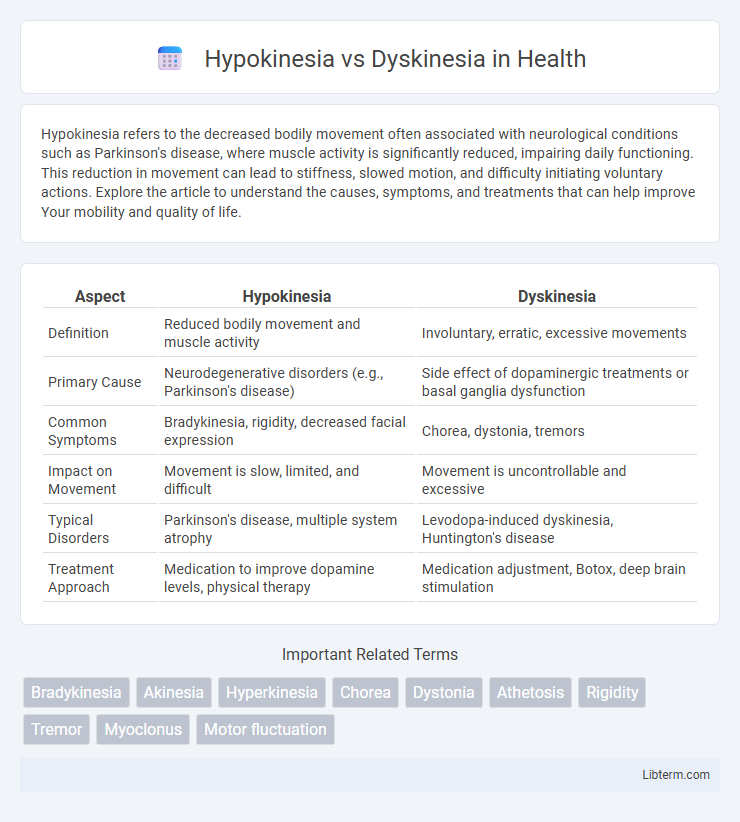Hypokinesia refers to the decreased bodily movement often associated with neurological conditions such as Parkinson's disease, where muscle activity is significantly reduced, impairing daily functioning. This reduction in movement can lead to stiffness, slowed motion, and difficulty initiating voluntary actions. Explore the article to understand the causes, symptoms, and treatments that can help improve Your mobility and quality of life.
Table of Comparison
| Aspect | Hypokinesia | Dyskinesia |
|---|---|---|
| Definition | Reduced bodily movement and muscle activity | Involuntary, erratic, excessive movements |
| Primary Cause | Neurodegenerative disorders (e.g., Parkinson's disease) | Side effect of dopaminergic treatments or basal ganglia dysfunction |
| Common Symptoms | Bradykinesia, rigidity, decreased facial expression | Chorea, dystonia, tremors |
| Impact on Movement | Movement is slow, limited, and difficult | Movement is uncontrollable and excessive |
| Typical Disorders | Parkinson's disease, multiple system atrophy | Levodopa-induced dyskinesia, Huntington's disease |
| Treatment Approach | Medication to improve dopamine levels, physical therapy | Medication adjustment, Botox, deep brain stimulation |
Introduction to Hypokinesia and Dyskinesia
Hypokinesia refers to the marked reduction in spontaneous movement, often observed in conditions like Parkinson's disease, characterized by rigidity and bradykinesia. Dyskinesia involves involuntary, erratic, and excessive movements typically resulting from long-term use of dopaminergic therapy in Parkinson's patients. Understanding these movement disorders is crucial for accurate diagnosis and tailored treatment strategies in neurodegenerative diseases.
Definition of Hypokinesia
Hypokinesia refers to a significant reduction in spontaneous movement and overall motor activity, commonly associated with neurological disorders such as Parkinson's disease. It manifests as slow, diminished, or absent voluntary movements, contrasting with dyskinesia, which involves involuntary, erratic, and excessive movements often induced by long-term dopaminergic treatment. Understanding hypokinesia is crucial for distinguishing motor impairments and tailoring effective therapeutic interventions in movement disorders.
Definition of Dyskinesia
Dyskinesia is characterized by involuntary, erratic, and often excessive movements that result from neurological conditions or medication side effects, contrasting with hypokinesia, which involves reduced or slowed movements. It commonly occurs in patients with Parkinson's disease as a complication of long-term dopaminergic therapy. The abnormal motor activity in dyskinesia significantly impairs voluntary motor control and daily functioning.
Key Differences Between Hypokinesia and Dyskinesia
Hypokinesia is characterized by a reduction in voluntary movement and slow physical activity, commonly seen in Parkinson's disease, whereas dyskinesia involves involuntary, erratic, and excessive movements, often as a side effect of long-term dopaminergic therapy. Hypokinesia typically manifests as rigidity, bradykinesia, and difficulty initiating movements, while dyskinesia presents with choreiform, dystonic, or ballistic involuntary muscle contractions. The key difference lies in hypokinesia representing a deficit in movement initiation and execution, whereas dyskinesia reflects an excess or abnormal movement control.
Causes of Hypokinesia
Hypokinesia primarily results from Parkinson's disease and other neurodegenerative disorders that impair dopamine production in the substantia nigra, leading to reduced voluntary movement. Other causes include drug-induced parkinsonism, stroke affecting motor pathways, and certain metabolic conditions disrupting basal ganglia function. Understanding the etiology of hypokinesia is crucial for differentiating it from dyskinesia, which involves involuntary, excessive movements often caused by long-term dopamine replacement therapy.
Causes of Dyskinesia
Dyskinesia primarily results from long-term use of dopaminergic medications, especially levodopa, in Parkinson's disease patients, causing abnormal involuntary movements. The underlying causes include dopamine receptor sensitization and altered basal ganglia circuitry leading to motor fluctuations. Genetic factors and neurochemical imbalances involving glutamate and serotonin systems also contribute to dyskinesia development.
Clinical Manifestations and Symptoms
Hypokinesia is characterized by reduced movement amplitude, bradykinesia, and muscle rigidity, commonly observed in Parkinson's disease patients, leading to difficulty initiating and sustaining voluntary movements. Dyskinesia presents as involuntary, erratic, and often choreic movements typically induced by long-term use of dopaminergic medications, manifesting as jerky, writhing, or twisting motions predominantly in limbs and trunk. Clinical distinction hinges on hypokinesia causing diminished motor activity, while dyskinesia involves excessive, uncontrolled motor hyperactivity impacting functional mobility.
Diagnostic Approaches
Diagnostic approaches for hypokinesia primarily involve clinical assessments such as the Unified Parkinson's Disease Rating Scale (UPDRS) to evaluate motor symptoms including reduced movement amplitude and slowness. Dyskinesia diagnosis relies on patient history, direct observation during medication cycles, and tools like the Abnormal Involuntary Movement Scale (AIMS) to quantify involuntary movements. Advanced imaging techniques such as dopamine transporter (DAT) SPECT scans and wearable motion sensors offer objective data to differentiate between hypokinetic and dyskinetic manifestations in movement disorders.
Treatment Options and Management Strategies
Treatment options for hypokinesia primarily involve dopamine replacement therapies, such as levodopa, and physical therapy to improve motor function and reduce rigidity. Dyskinesia management focuses on adjusting dopaminergic medications, including the use of amantadine or deep brain stimulation (DBS) to alleviate involuntary movements. Both conditions benefit from individualized rehabilitation programs, incorporating occupational therapy and lifestyle modifications to enhance quality of life and functional independence.
Prognosis and Quality of Life Considerations
Hypokinesia, characterized by reduced movement, often leads to progressive mobility decline and increased risk of falls, significantly impacting long-term prognosis and quality of life. Dyskinesia involves involuntary, erratic movements typically resulting from long-term dopaminergic therapy, which can cause fluctuations in motor function and distress, complicating management and daily living activities. Effective control of symptoms through tailored medical and rehabilitative approaches is crucial to optimizing prognosis and enhancing overall quality of life in both conditions.
Hypokinesia Infographic

 libterm.com
libterm.com